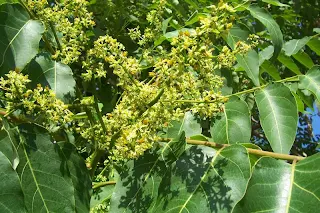Ailant honey plant description, properties, application and distribution
Ailantus honey plant is the highest tree from the genus Ailanthus.
Ailanthus
is originally from
Content
- Description of the honey plant ailanthus
- Ailant as a honey plant
- Aylanthus honey plant in protective afforestation
- Ailant honey plant in landscape design
- Economic importance of ailanthus honey plant
- Ailanthus wood
.
Description of the honey plant ailanthus
Ailanthus
honey plant is a tree that reaches a height of 25-
Ailanthus
shoots are long, yellowish brown, smooth, shiny. The kidneys are alternate, up
to
Leaves of
ailanthus are pinnately compound, alternate, up to
Ailanthus
flowers are small, greenish in color, bisexual and staminate, flowers are
collected in panicles 10-
Ailanthus fruits
are oblong elliptical lionfish, pointed at both ends, light yellow in color,
with an orange-red tint. They are 3-
The root
system of ailanthus is superficial, very strongly developed, easily forms
shoots from the roots.
On the
southern coast of
Ailanthus as a honey plant
Ailanthus
as a honey plant blooms in May - June, during flowering ailanthus attracts many
bees. The nectar productivity of one flower is from 2.5 to 3.1 mg with a sugar
content of 45-51%. The honey productivity of an ailanthus from an average tree
up to
According
to Romanian researchers, the honey productivity of ailanthus is more than 300
kg/ha.
In
Ailanthus honey plant in protective afforestation
Ailant
honey plant is a light-loving, very fast growing tree, at a young age it grows
up to
Ailant
honey plant is not picky about the soil, it can grow quite well on washed-out
loams, rocky slopes, on sands and other infertile soils.
Ailantus
honey plant is drought-resistant, it is able to tolerate not only atmospheric
drought, but also soil drought. At the same time, it is resistant to slight
salinization of the soil.
Ailanthus
is not resistant to frost, so it cannot quickly move north, but gradually it
acclimatizes and slowly moves north and can even be found in the central
regions of European Russia. In
Due to its
unpretentiousness and ability to form a large number of root suckers, the
ailant honey plant is used to fix the slopes of ravines, to fix the slopes, to
fix the sands.
Ailant
honey plant was widely used to create soil-protective forest belts on chestnut
solonetsous soils.
Ailant
honey plant is considered one of the best breeds for afforestation in the lower
zone up to
Because of
the ability of ailanthus to give off an unpleasant odor, it is used to create
green umbrellas. Because the smell emitted by ailanthus repels harmful insects
from animals.
The
advantages of ailanthus, due to which it was introduced into the culture, is
its disadvantage.
From
cultivated plantings, it can spread and grow wild. Due to its ability to form
root offspring and herbicidal properties, it can gradually crowd out native
species. For this reason, in 2014 it was included in the register of regulated
non-quarantine pests on the territory of the
List of
quarantine objects.
Ailanthus
is recognized as an invasive species in
Aylanthus honey plant in landscape design
Ailantus
honey plant is an ornamental tree, ailanthus has a slender trunk, with
beautiful smooth bark, it has huge leaves, like a palm tree and caps of
orange-red fruits. This gives the tree a particularly attractive appearance.
For this reason, ailanthus is very often used in single plantings, in parks,
squares, and gardens. For the purposes of landscape design, decorative forms of
ailanthus are distinguished, such as white variegated, red-fruited, weeping and
other forms.
Economic importance of ailanthus
The
ailanthus honey plant is a very fast-growing tree, therefore, ailanthus
plantations are created abroad with short felling rotations in order to obtain
a large amount of ailanthus wood. At the same time, more wood raw material for
cellulose is obtained from ailanthus than from other tree species, which
increases the yield of cellulose. Cellulose obtained from ailanthus has a light
color, which makes it easier to bleach.
In
plantations, the ailanthus at the age of five reaches
In
industrial plantations in some countries, felling is carried out when the trees
reach
Due to its
rapid growth, unpretentiousness to growing conditions and the ability to
produce rapidly growing root shoots, it is possible to use ailanthus for
plantation cultivation in the southern regions, to obtain firewood and wood for
other purposes. So, in favorable conditions of
In its
homeland, ailanthus is used to feed the ailanthus silkworm.
Flowers,
young shoots, young bark, mature fruits are used in folk medicine.
Ailant is a
good honey plant, which is important for the southern regions.
Ailanthus wood
Ailanthus
wood is annular-porous, with a wide sapwood of light yellowish and yellow-gray
color with greenish veins, a shiny heartwood. Annual rings are usually wide,
distinctly different due to the accumulation of large pores of vessels in
spring wood. The medullary rays are numerous, narrow and shiny. In the center
of the wood core, there usually remains a non-lignified core with a diameter of
up to
The
physical and mechanical properties of ailanthus wood are quite high. The
volumetric weight varies from 0.56 to 0.68. The strength of ailanthus wood is


Комментариев нет:
Отправить комментарий